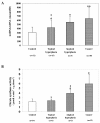Mitochondrial DNA content and mass increase in progression from normal to hyperplastic to cancer endometrium
- PMID: 22676897
- PMCID: PMC3502111
- DOI: 10.1186/1756-0500-5-279
Mitochondrial DNA content and mass increase in progression from normal to hyperplastic to cancer endometrium
Abstract
Background: An increase in mitochondrial DNA (mtDNA) content and mitochondrial biogenesis associated with the activation of PGC-1α signalling pathway was previously reported in type I endometrial cancer. The aim of this study has been to evaluate if mtDNA content and the citrate synthase (CS) activity, an enzyme marker of mitochondrial mass, increase in progression from control endometrium to hyperplasia to type I endometrial carcinoma.
Results: Given that no statistically significant change in mtDNA content and CS activity in endometrium taken from different phases of the menstrual cycle or in menopause was found, these samples were used as control. Our research shows, for the first time, that mtDNA content and citrate synthase activity increase in hyperplastic endometrium compared to control tissues, even if their levels remain lower compared to cancer tissue. In particular, mtDNA content increases seem to precede increases in CS activity. No statistically significant change in mtDNA content and in CS activity was found in relation to different histopathological conditions such as grade, myometrial invasion and stage.
Conclusion: MtDNA content and citrate synthase activity increases in pre-malignant lesions could be a potential molecular marker for progression from hyperplasia to carcinoma.
Figures

Similar articles
-
Total sialic acid content in endometrial cancer tissue in relation to normal and hyperplastic human endometrium.Cancer Detect Prev. 2000;24(5):459-63. Cancer Detect Prev. 2000. PMID: 11129988
-
Significance of matrix metalloproteinase-7 [correction of matrix metalloproteinase-2], -11 and tissue inhibitor of metalloproteinase-1 expression in normal, hyperplastic and neoplastic endometrium.Anticancer Res. 2007 Jan-Feb;27(1A):95-105. Anticancer Res. 2007. PMID: 17352221
-
Immunohistochemical analysis of c-myc, c-jun and estrogen receptor in normal, hyperplastic and neoplastic endometrium.Pathol Oncol Res. 2005;11(1):32-9. doi: 10.1007/BF03032403. Epub 2005 Mar 31. Pathol Oncol Res. 2005. PMID: 15800680
-
The PGC-1alpha-dependent pathway of mitochondrial biogenesis is upregulated in type I endometrial cancer.Biochem Biophys Res Commun. 2009 Dec 25;390(4):1182-5. doi: 10.1016/j.bbrc.2009.10.114. Epub 2009 Oct 25. Biochem Biophys Res Commun. 2009. PMID: 19861117
-
Thymidine phosphorylase activity in normal, hyperplastic and neoplastic endometrium--correlation with intratumoral angiogenesis.Adv Exp Med Biol. 2000;476:297-303. doi: 10.1007/978-1-4615-4221-6_24. Adv Exp Med Biol. 2000. PMID: 10949674 Review. No abstract available.
Cited by
-
Respiratory Complex I dysfunction in cancer: from a maze of cellular adaptive responses to potential therapeutic strategies.FEBS J. 2022 Dec;289(24):8003-8019. doi: 10.1111/febs.16218. Epub 2021 Oct 18. FEBS J. 2022. PMID: 34606156 Free PMC article. Review.
-
Lactic Acidosis Promotes Mitochondrial Biogenesis in Lung Adenocarcinoma Cells, Supporting Proliferation Under Normoxia or Survival Under Hypoxia.Front Oncol. 2019 Oct 17;9:1053. doi: 10.3389/fonc.2019.01053. eCollection 2019. Front Oncol. 2019. PMID: 31681589 Free PMC article.
-
Lactate Induces the Expressions of MCT1 and HCAR1 to Promote Tumor Growth and Progression in Glioblastoma.Front Oncol. 2022 Apr 28;12:871798. doi: 10.3389/fonc.2022.871798. eCollection 2022. Front Oncol. 2022. PMID: 35574309 Free PMC article.
-
PGC1α: Friend or Foe in Cancer?Genes (Basel). 2018 Jan 22;9(1):48. doi: 10.3390/genes9010048. Genes (Basel). 2018. PMID: 29361779 Free PMC article. Review.
-
Role of Signaling Molecules in Mitochondrial Stress Response.Front Genet. 2018 Jul 10;9:225. doi: 10.3389/fgene.2018.00225. eCollection 2018. Front Genet. 2018. PMID: 30042784 Free PMC article.
References
-
- Linkov F, Edwards R, Balk J, Yurkovetsky Z, Stadterman B, Lokshin A, Taioli E. Endometrial hyperplasia, endometrial cancer and prevention: gaps in existing research of modifiable risk factors. Eur J Cancer. 2008;12:1632–1644. - PubMed
-
- Warburg O. On respiratory impairment in cancer cells. Science. 1956;124:269–270. - PubMed
Publication types
MeSH terms
Substances
LinkOut - more resources
Full Text Sources

